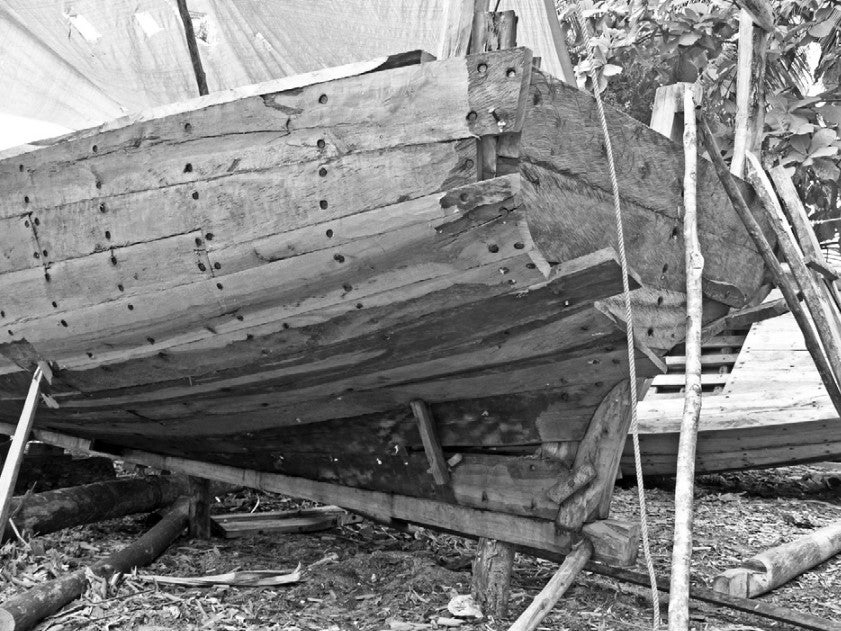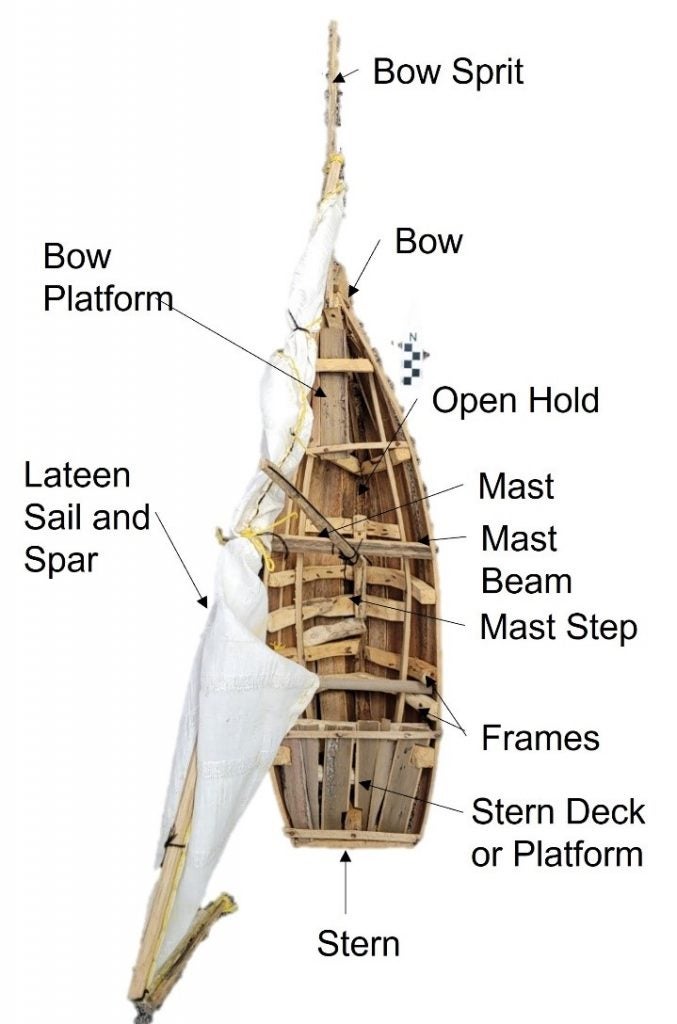Dhows in Zanzibar and Tanzania
Dhows in Zanzibar are an evolutionary tale of many influences on a craft first introduced to the region by Arab traders. Some of the characteristics of the larger sea-going dhows made in Zanzibar are a clipper-like bow, a transom vice a double ended construction, and reliance on sails as the primary motive power even when equipped with small motors for maneuvering in-shore (Falk 2013:165).
Dhow builders, like many traditional artisans are fading away into the obscurity of the past. However, the few remaining traditional dhow builders still use the techniques and hand tools passed down over generations. In many cases, these builders use no wooden fasteners, nails or screws, but rely on treenails carved from mangrove roots (NatGeo).
The trading dhows in Zanzibar are equipped with one large lateen sail rigged on a forward leaning main mast. This configuration requires fewer stays and rigging than other types of rigs and the large sail is versatile over a wide variety of wind conditions. The benefit of this rig to trading vessels is allowing them to stay near the coast as they travel the trading routes along the west coast of Africa. Because of their versatility and cheaper operation, dhows were the mainstay of marine transportation in the region well after the introduction of steamers (Gilbert NP:62-65).
Traditional Construction Methods
The dhows are laid out and constructed by eye with no plans. Hammers, hand saws, and hand drills are the traditional tools used. Some builders will use hand-poured nails, but many use treenails made form mangrove roots or other hardwoods. Each step is carried out in a roughhewn fashion and smoothing surfaces and finishing is done at the end before painting (Falck 2013:172).

Figure 1: Laying the keel, stem post, and stern post (Photo: W. E. Falck).

Figure 2: Hooked scarf between stem and keel, Nungwi, Zanzibar (Photo: W. E. Falck).

Figure 3: Timbering-out a hull, Nungwi, Zanzibar (Photo: W. E. Falck).

Figure 4: Transom of a new dhow before the planking
is trimmed flush with, Nungwi, Zanzibar (Photo: W. E. Falck).
Description of Model Dhow
This model of a Zanzibar trading dhow was hand built by a professor and a student at East Carolina University for the purpose of representing the traditional craft in the traditional manner of construction. The bow is straight, flaring to a rounded upraised gunwale. From the plan view, one sees a sharp, narrow prow melding into a broad, rounded midships and straight, wineglass transom.
Tables of Scantlings (all measurements in centimeters)
Length (Plan View)
| LOA | 90.2 |
| L Hull | 62.5 |
| L Bowsprit | 27.7 |
| Beam at Mast | 19 |
| 11 | 8.5 |
| 14 | 13.8 |
| 42 | 20 |
| 50 | 19.5 |
| Stern | 13.5 |
(Measurements taken on centerline, from stem to stern.)
Height (Profile View)
| Stern | 11.8 |
| 10 | 12 |
| 20 | 12.8 |
| 30 | 14 |
| 40 | 15 |
| At Stem | 17 |
| Length of Stem | 22.5 |
(Measurements taken from bottom of keel to top of gunwale, from stern to stem.)
Photographs of Model

Figure 5. Plan view of model with Labels.
Figure 6. Profile view of model with Labels.
Figure 7. Bow view of model with Labels.
Figure 8. Stern view of model with Labels.
Wire Diagrams
Figure 9. Plan outline of model.
Figure 10. Profile outline of model.
Sketches
Figure 11. Plan sketch of model.
Figure 12. Profile sketch of model.
Figure 13. Detail of scarfed stern and stem posts.
Figure 14: Scale Drawing at ½ Scale.
References
Falk, W. Eberhard
2013 “Boats and Boatbuilding (Dar-es Salaam and Zanzibar).” The International Journal of Nautical Archaeology, 03 December 2013. https://doi.org/10.1111/1095-9270.12049
Gilbert, Erik O.
1997 The Zanzibar Dhow Trade: An Informal Economy on the East African Coast, 1860-1964. Order No. 9713661, Boston University.
National Geographic
“Zanzibar Dhow.” National geographic TV. Zanzibar Dhow | National Geographic – YouTube
fashion and smoothing surfaces and finishing is done at the end before painting (Falck 2013:172).
Figure 1: Laying the keel, stem post, and stern post (Photo: W. E. Falck).
Figure 2: Hooked scarf between stem and keel, Nungwi, Zanzibar (Photo: W. E. Falck).
Figure 3: Timbering-out a hull, Nungwi, Zanzibar (Photo: W. E. Falck).
Figure 4: Transom of a new dhow before the planking is trimmed flush with it, Nungwi, Zanzibar (Photo: W. E. Falck).
Description of Model Dhow
This model of a Zanzibar trading dhow was hand built by a professor and a student at East Carolina University for the purpose of representing the traditional craft in the traditional manner of construction. The bow is straight, flaring to a rounded upraised gunwale. From the plan view, one sees a sharp, narrow prow melding into a broad, rounded midships and straight, wineglass transom.
Tables of Scantlings (all measurements in centimeters)
Length (Plan View)
| LOA | 90.2 |
| L Hull | 62.5 |
| L Bowsprit | 27.7 |
| Beam at Mast | 19 |
| 11 | 8.5 |
| 14 | 13.8 |
| 42 | 20 |
| 50 | 19.5 |
| Stern | 13.5 |
(Measurements taken on centerline, from stem to stern.)
Height (Profile View)
| Stern | 11.8 |
| 10 | 12 |
| 20 | 12.8 |
| 30 | 14 |
| 40 | 15 |
| At Stem | 17 |
| Length of Stem | 22.5 |
(Measurements taken from bottom of keel to top of gunwale, from stern to stem.)
Photographs of Model
Figure 5. Plan view of model with Labels.
Figure 6. Profile view of model with Labels.
Figure 7. Bow view of model with Labels.
Figure 8. Stern view of model with Labels.
Wire Diagrams
Figure 9. Plan outline of model.
Figure 10. Profile outline of model.
Sketches
Figure 11. Plan sketch of model.
Figure 12. Profile sketch of model.
Figure 13. Detail of scarfed stern and stem posts.
Figure 14: Scale Drawing at ½ Scale.
References
Falk, W. Eberhard
2013 “Boats and Boatbuilding (Dar-es Salaam and Zanzibar).” The International Journal of Nautical Archaeology, 03 December 2013. https://doi.org/10.1111/1095-9270.12049
Gilbert, Erik O.
1997 The Zanzibar Dhow Tra
fashion and smoothing surfaces and finishing is done at the end before painting (Falck 2013:172).
Figure 1: Laying the keel, stem post, and stern post (Photo: W. E. Falck).
Figure 2: Hooked scarf between stem and keel, Nungwi, Zanzibar (Photo: W. E. Falck).
Figure 3: Timbering-out a hull, Nungwi, Zanzibar (Photo: W. E. Falck).
Figure 4: Transom of a new dhow before the planking is trimmed flush with it, Nungwi, Zanzibar (Photo: W. E. Falck).
Description of Model Dhow
This model of a Zanzibar trading dhow was hand built by a professor and a student at East Carolina University for the purpose of representing the traditional craft in the traditional manner of construction. The bow is straight, flaring to a rounded upraised gunwale. From the plan view, one sees a sharp, narrow prow melding into a broad, rounded midships and straight, wineglass transom.
Tables of Scantlings (all measurements in centimeters)
Length (Plan View)
| LOA | 90.2 |
| L Hull | 62.5 |
| L Bowsprit | 27.7 |
| Beam at Mast | 19 |
| 11 | 8.5 |
| 14 | 13.8 |
| 42 | 20 |
| 50 | 19.5 |
| Stern | 13.5 |
(Measurements taken on centerline, from stem to stern.)
Height (Profile View)
| Stern | 11.8 |
| 10 | 12 |
| 20 | 12.8 |
| 30 | 14 |
| 40 | 15 |
| At Stem | 17 |
| Length of Stem | 22.5 |
(Measurements taken from bottom of keel to top of gunwale, from stern to stem.)
Photographs of Model
Figure 5. Plan view of model with Labels.
Figure 6. Profile view of model with Labels.
Figure 7. Bow view of model with Labels.
Figure 8. Stern view of model with Labels.
Wire Diagrams
Figure 9. Plan outline of model.
Figure 10. Profile outline of model.
Sketches
Figure 11. Plan sketch of model.
Figure 12. Profile sketch of model.
Figure 13. Detail of scarfed stern and stem posts.
Figure 14: Scale Drawing at ½ Scale.
References
Falk, W. Eberhard
2013 “Boats and Boatbuilding (Dar-es Salaam and Zanzibar).” The International Journal of Nautical Archaeology, 03 December 2013. https://doi.org/10.1111/1095-9270.12049
Gilbert, Erik O.
1997 The Zanzibar Dhow Trade: An Informal Economy on the East African Coast, 1860-1964. Order No. 9713661, Boston University.
National Geographic
“Zanzibar Dhow.” National geographic TV. Zanzibar Dhow | National Geographic – YouTube
fashion and smoothing surfaces and finishing is done at the end before painting (Falck 2013:172).
Figure 1: Laying the keel, stem post, and stern post (Photo: W. E. Falck).
Figure 2: Hooked scarf between stem and keel, Nungwi, Zanzibar (Photo: W. E. Falck).
Figure 3: Timbering-out a hull, Nungwi, Zanzibar (Photo: W. E. Falck).
Figure 4: Transom of a new dhow before the planking is trimmed flush with it, Nungwi, Zanzibar (Photo: W. E. Falck).
Description of Model Dhow
This model of a Zanzibar trading dhow was hand built by a professor and a student at East Carolina University for the purpose of representing the traditional craft in the traditional manner of construction. The bow is straight, flaring to a rounded upraised gunwale. From the plan view, one sees a sharp, narrow prow melding into a broad, rounded midships and straight, wineglass transom.
Tables of Scantlings (all measurements in centimeters)
Length (Plan View)
| LOA | 90.2 |
| L Hull | 62.5 |
| L Bowsprit | 27.7 |
| Beam at Mast | 19 |
| 11 | 8.5 |
| 14 | 13.8 |
| 42 | 20 |
| 50 | 19.5 |
| Stern | 13.5 |
(Measurements taken on centerline, from stem to stern.)
Height (Profile View)
| Stern | 11.8 |
| 10 | 12 |
| 20 | 12.8 |
| 30 | 14 |
| 40 | 15 |
| At Stem | 17 |
| Length of Stem | 22.5 |
(Measurements taken from bottom of keel to top of gunwale, from stern to stem.)
Photographs of Model
Figure 5. Plan view of model with Labels.
Figure 6. Profile view of model with Labels.
Figure 7. Bow view of model with Labels.
Figure 8. Stern view of model with Labels.
Wire Diagrams
Figure 9. Plan outline of model.
Figure 10. Profile outline of model.
Sketches
Figure 11. Plan sketch of model.
Figure 12. Profile sketch of model.
Figure 13. Detail of scarfed stern and stem posts.
Figure 14: Scale Drawing at ½ Scale.
References
Falk, W. Eberhard
2013 “Boats and Boatbuilding (Dar-es Salaam and Zanzibar).” The International Journal of Nautical Archaeology, 03 December 2013. https://doi.org/10.1111/1095-9270.12049
Gilbert, Erik O.
1997 The Zanzibar Dhow Trade: An Informal Economy on the East African Coast, 1860-1964. Order No. 9713661, Boston University.
National Geographic
“Zanzibar Dhow.” National geographic TV. Zanzibar Dhow | National Geographic – YouTubee: An Informal Economy on the East African Coast, 1860-1964. Order No. 9713661, Boston University.
National Geographic
“Zanzibar Dhow.” National geographic TV. Zanzibar Dhow | National Geographic – YouTube